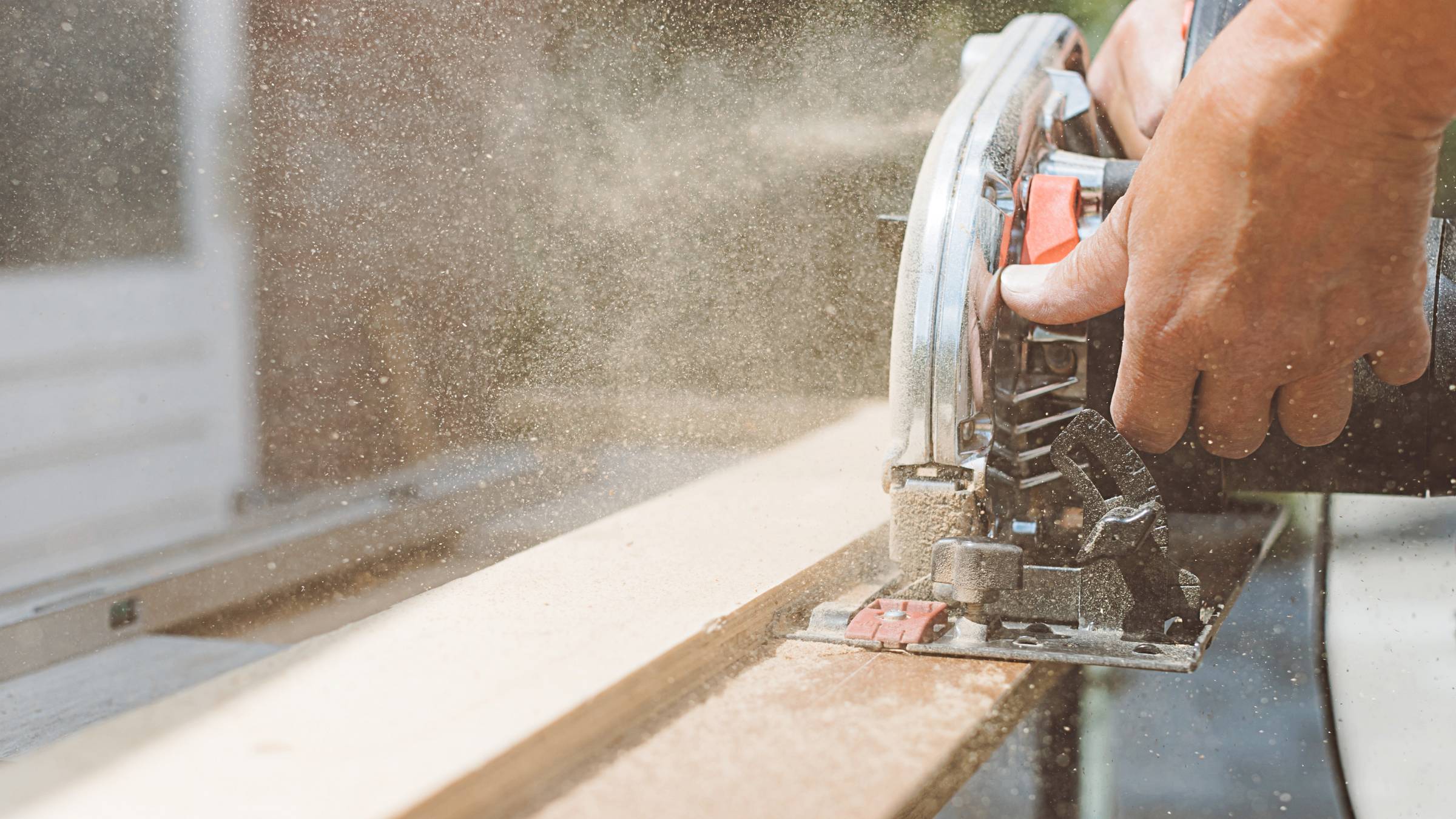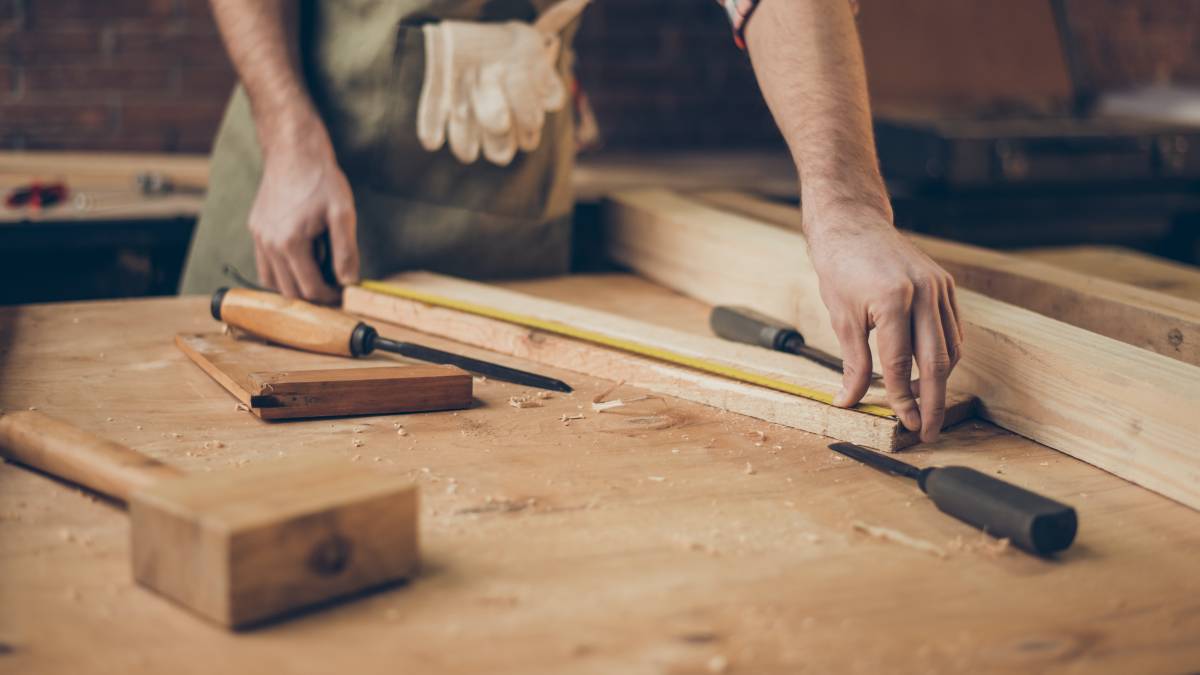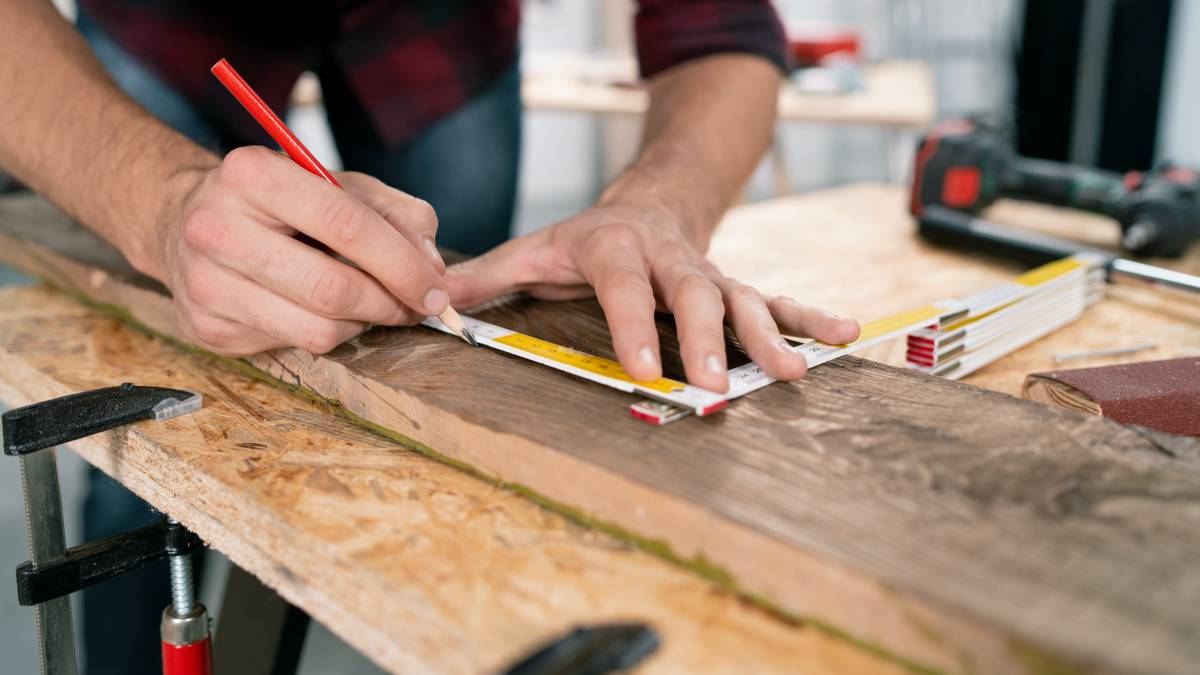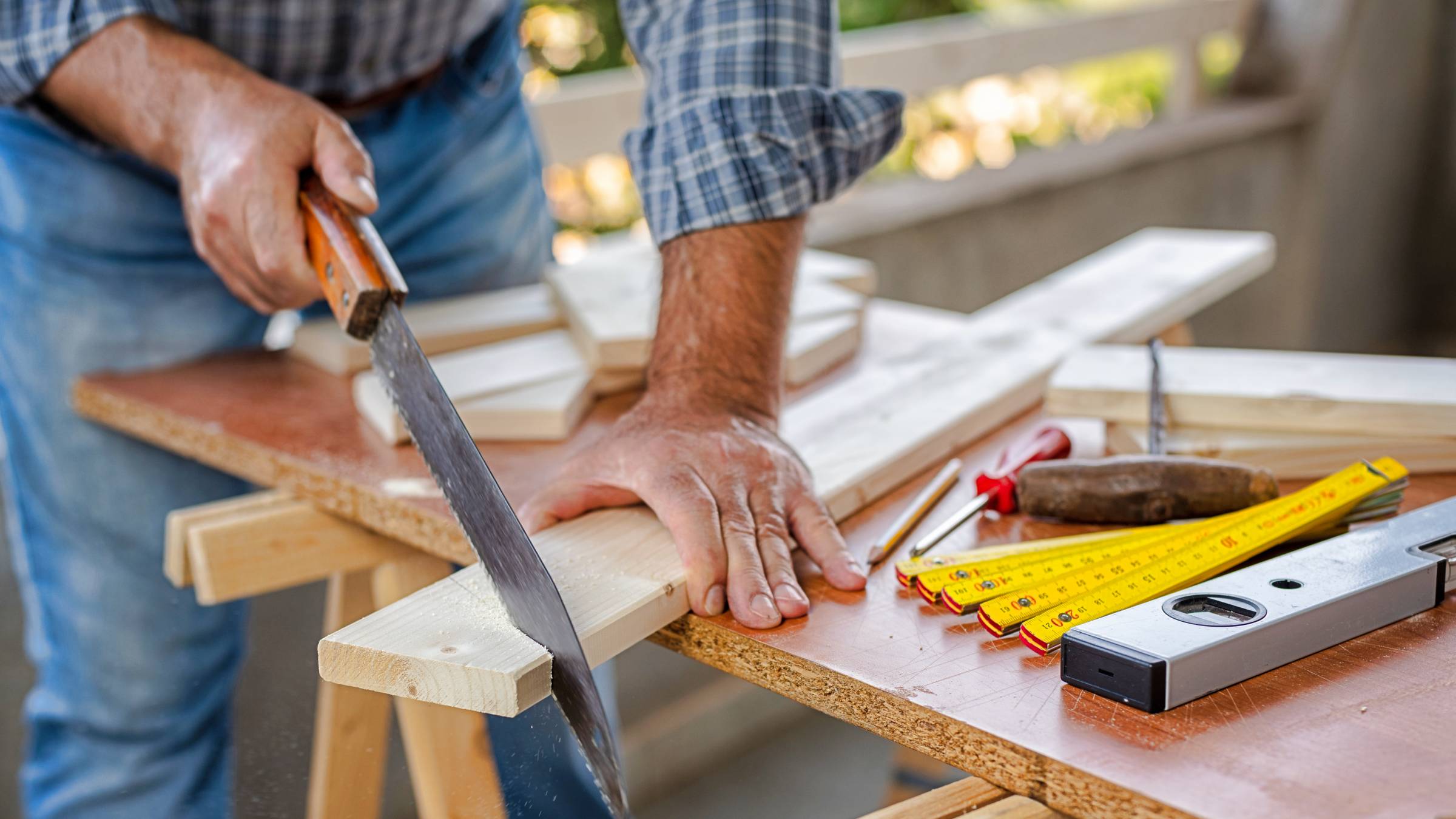
Carpentry tools list: 21 must-haves for every woodworker
Building your arsenal of woodworking tools
Explore carpenter jobsLast Updated on
Key Takeaways
- Carpenters typically use over 20 tools, ranging from basic hand tools to advanced power tools.
- Essentials include hammers, saws, measuring tapes, squares, chisels, and drills.
- Power tools like circular saws and nail guns are common upgrades for experienced carpenters.
Do you love to build decks and furniture? Do your friends and family call you when they need help with repairs? Or are you someone who dreams of earning money with your carpentry skills?
Here’s good news for you: you can. Even better, you can make money even with a few core supplies. This carpentry tools list shares 21 must-haves. From basic hand tools to power machines, these things can help you get the job done quickly and excellently.
Hand tools for carpenters
 Driving nails with a claw hammer is a basic yet essential carpentry task (Source: iStock)
Driving nails with a claw hammer is a basic yet essential carpentry task (Source: iStock)
As their name suggests, hand tools are non-powered woodworking tools operated and manipulated directly by hand (or your muscles). Some common categories and examples include the following:
Measuring tools, such as tape measures, rulers, and calipers
Cutting tools, like handsaws, knives, and scissors
Striking tools, such as claw hammers, mallets, and punches
Gripping tools, like pliers, wrenches, clamps, and vise grips
Turning and driving tools such as screwdrivers, wrenches, and ratchets
Sharpening and shaping tools, like files, rasps, whetstones, and planes
Demolition tools, such as crowbars, sledgehammers, and pry bars
Layout and marking tools, such as chalk lines, pencils, rules, squares, and dividers
Hand tools are less ergonomic than power tools. They increase your risk of injury and inaccuracy because of fatigue. However, they are portable and provide control and precision for a detailed woodworking project, such as building custom furniture.
The following should be part of your must-have carpentry hand tools list:
1. Screwdrivers
Screwdrivers are essential carpentry tools for driving screws to join materials on drywalls and wood. The most common types are the following:
Slotted screwdrivers have a single flat blade tip that fits into the single slot on a screw head.
Phillips screwdrivers have a cross-shaped tip that goes into the cross indentation on Phillips screws. The shape allows the screwdriver to stay centered on the screw head.
Torx drivers have a star shape to fit Torx screw heads.
Hex drivers have a hexagonal tip.
Carpenters typically carry slotted and Phillips screwdrivers in various sizes, with shaft lengths ranging from 4 to over 8 inches for increased leverage. Quality screwdrivers have hardened steel shafts and durable, slip-resistant handles, such as a rubberized grip.
2. Claw hammers
The claw hammer is one of the essential beginner woodworking tools. It has a flat metal head on one side for hammering nails and a curved, split claw on the other for removing nails.
Additionally, a claw hammer typically has a 13- to 16-inch wooden handle with a rubberized grip. The balance between the head and handle makes them ideal for precision nailing and pulling.
3. Marking knives
A marking knife is a hand tool that precisely marks and cuts lines on wood. It typically has a thin 2- to 3-inch fixed or folding steel blade. The sharp point effortlessly slices wood fibers, while the narrow blade allows accurate straight or curved lines.
Marking knives enable detailed layout before cutting, with the knife cuts helping prevent tear-outs when sawing across the grain. The blades come in specialized shapes that control cut depth. Quality marking knives have comfortable handles and lock securely when folded for safe storage.
4. Miter boxes
A miter box is one of the basic woodworking tools. It guides a backsaw or handsaw for making precise crosscuts at desired angles. Usually made of wood and other materials such as plastic or metal, the slots restrict the blade’s motion to create angles or straight cuts.
Portable miter boxes fold down for transport and storage. Meanwhile, stationary shop models are permanently mounted to a workbench.
5. Wrenches
A wrench is a hand tool for gripping, turning, and applying torque to screws or bolts and other fasteners. Made from hardened steel or chrome vanadium, it has a flat or shaped jaw on the head that grips onto the faces of fasteners.
There are several common wrench types, each suited for different purposes:
Open-end wrenches have a U-shape that is useful for turning nuts and bolts in tight spaces ,but cannot grip as strongly.
Box-end wrenches enclose the entire fastener in a deep socket, enabling much more torque to be applied without slipping or rounding off corners.
Adjustable wrenches have movable steel jaws controlled by a worm drive, so they can grip various fastener sizes when the exact size is unknown.
Other specialized wrench types include Allen, torque, pipe, and socket wrenches used with ratchets.
6. Chisels
Chisels are hand tools with sharp edges for shaping, carving, and cutting wood. There are many types of specialty chisels designed for a woodworking job:
A mortise chisel has a thick, strong blade to chop out rectangular mortises that allow the insertion of door hinges and other hardware.
A paring chisel has a thinner, more flexible blade ideal for general-purpose trimming, smoothing, and fine final cuts on woodworking projects.
In addition to the mortise and paring chisels, other common types on a hand-tools list are framing, carving, gouge, dovetail, and butt chisels.
7. Utility knives
Also known as box cutters, these are multipurpose essential carpentry tools used for cutting various materials. A good utility knife has a retractable blade you can swap with a fresh edge. The thin, pointed blades make precise, straight cuts, which are impossible with scissors or shears.
A utility knife is ideal for cutting drywall, cardboard, plastic sheeting, roofing shingles, carpeting, and wallpaper. It also slices through rope, fabric, and other soft materials.
8. Tape measures
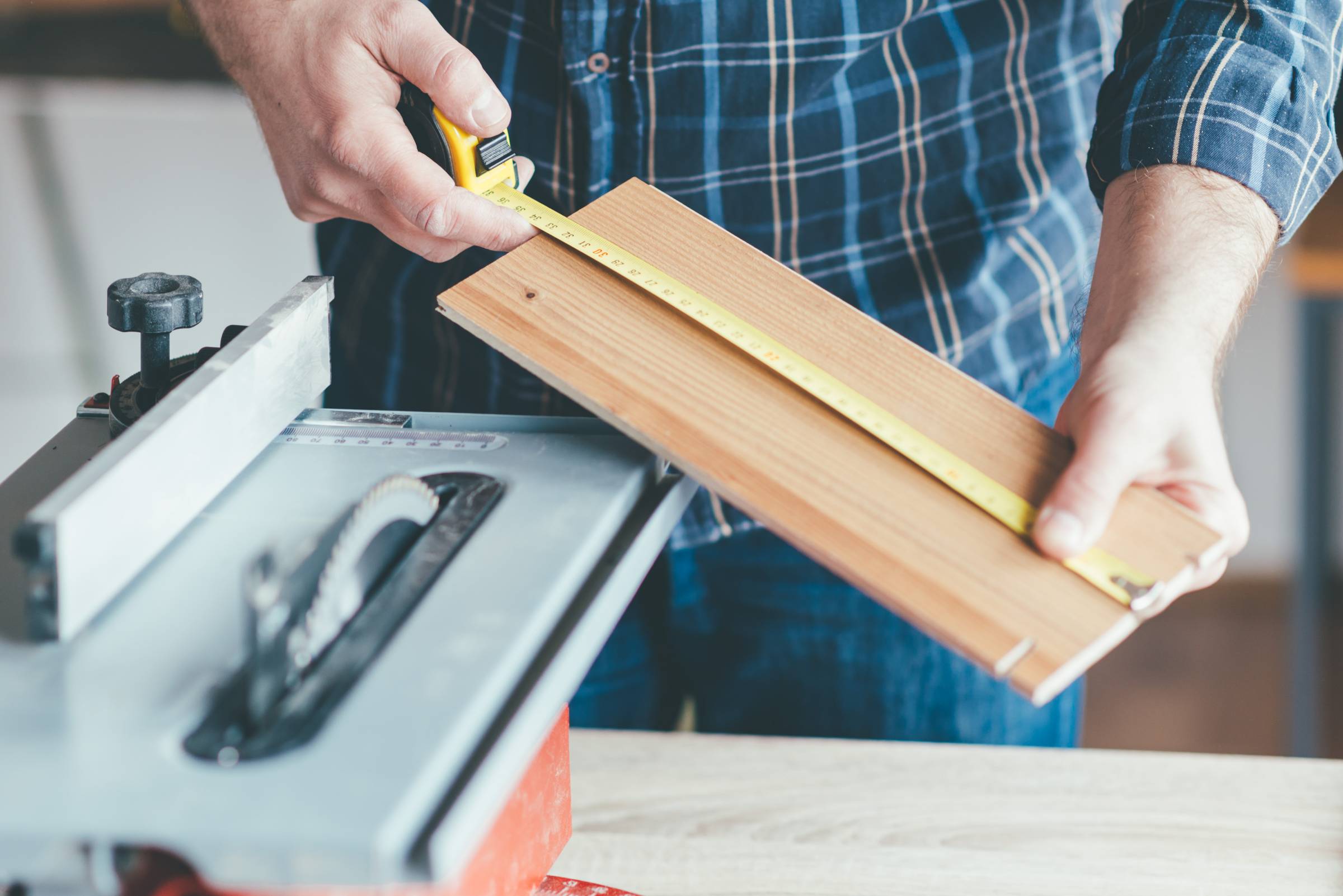 A quality tape measure ensures every cut and joint is accurate (Source: iStock)
A quality tape measure ensures every cut and joint is accurate (Source: iStock)
A tape measure is an indispensable tool for professional carpenters. It allows quick and accurate measurement of boards, panels, fixtures, and spaces to guide cutting, installation, and layout.
Furthermore, a tape measure comes in a retractable steel casing of various lengths, usually up to 50 feet. The flexible tape is marked in standard and metric increments and retracts at the push of a button.
It also often has additional marking features like stud markers to center layouts across framing. The magnetic end clings to metal surfaces and keeps the tape end at the measurement point temporarily.
9. Squares
Squares are layout and measuring tools used in carpentry to mark perpendicular lines, check right angles, and ensure straight edges. It comes in different types:
The combination square has a steelhead that slides along a ruler for adjustable measurements. It can mark straight edges on boards and layout lines at 90- or 45-degree angles, making the combination square essential for joinery and good fits.
A speed square is a compact right triangle used one-handed to check board edges during cutting and nailing tasks quickly.
With its long overlapping arms, the framing square defines perfect right angles for housing frames and stair layouts.
10. Hand saws
Hand saws are essential carpenter tools for manually cutting wood pieces and joints. The thin, rigid blade has sharp teeth designed to sever wood fibers through back-and-forth motions. Examples of this type include:
Like a panel saw, a crosscut saw has teeth angled to slice across the wood grain for trimming lengths and widths.
A ripsaw has teeth to shave along the grain for splitting boards and removing waste.
A Japanese pull saw cuts on the pull stroke for enhanced control and accuracy on fine work.
Bow saws tension a narrow blade in a metal frame to tackle curved cuts.
A coping saw and a dovetail saw feature thin, flexible blades held in a pistol-grip handle for intricate cuts like joints.
A track saw rides a guide rail to produce straight, precise cuts over longer distances.
11. Sliding bevels
A sliding bevel is one of the carpenter tools to measure and transfer angles. An adjustable blade slides and pivots on a handle to match any angle setting. To use it, the angle is set by matching the blade to a sample angle. The blade can then be locked in place and used to transfer that precise angle when drawing lines or marking workpieces.
12. Scissors and snips
Scissors and snips are hand-cutting tools used in carpentry and construction for slicing fabric, paper, metal, and other thin materials.
A scissor has two crossed and pivoting blades operated using finger loops. For soft materials, it offers more finesse and detail than a utility knife.
A snip, also called sheet metal shears, is one of the sharp tools that enables effortless cutting of metal up to 16-gauge thickness. It is often safer than a typical knife or a saw to cut metal.
13. Marking tools and gauges
A marking tool transfers measurements from plans onto wood before cutting or shaping. Meanwhile, a marking gauge outlines parallel lines for joints and grooves.
For instance, a mortise gauge scribes centered lines for mortise and tenon joinery. A chalk line snaps long, straight lines. A marking knife is one of the only hand tools that score lines to prevent splintering when sawing across the wood grain.
With these basic hand tools, a carpenter can carefully lay out all needed cuts and joints before touching a saw or chisel to the woodworking project.
14. Planes
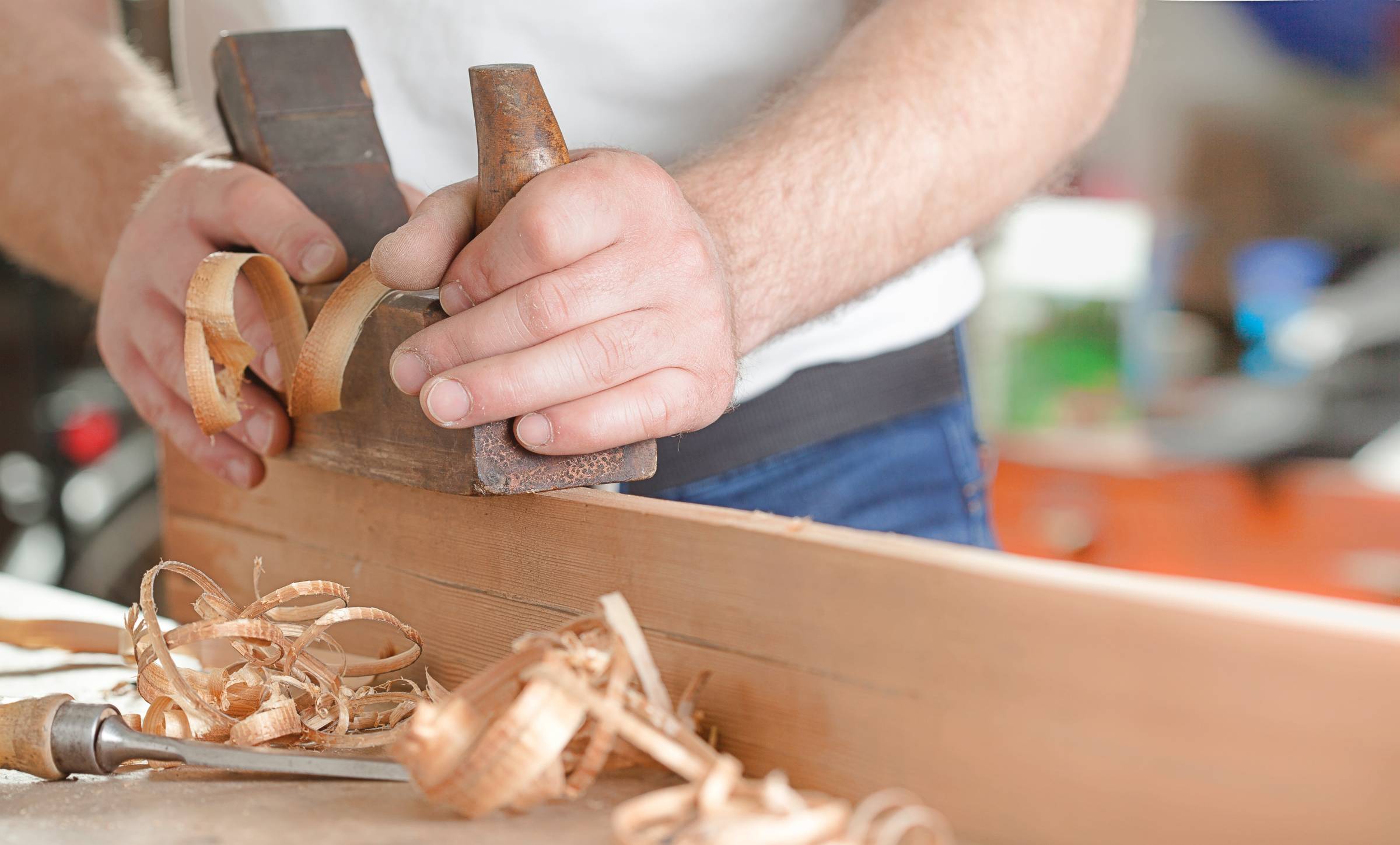 Traditional hand planes are ideal for finishing wood surfaces smoothly (Source: iStock)
Traditional hand planes are ideal for finishing wood surfaces smoothly (Source: iStock)
Planes are essential tools in carpentry used for smoothing, trimming, and shaping wood surfaces. A hand plane has a flat steel blade set at a consistent angle within a wood or metal body. Pushing its plane body over a board shaves off thin strips of material.
A block plane is compact for portability and trims the end grains or small areas before installing door hinges. A smoothing plane has a longer sole for flattening larger surfaces. Meanwhile, a jack plane quickly removes stock for thicknessing rough boards. Specialty planes include rabbet, shoulder, and chamfer planes designed to cut specific edge profiles.
15. Hole punches
A hole punch is a hand tool used to cut holes in various materials. The cutting edge is typically a round hollow cavity that produces a circular hole with each handle squeeze. Hole punches come in different sizes, from small, around 1/8 inch, up to a large 1 inch or more.
A larger, heavy-duty hole punch cuts through thicker and stronger materials using compound leverage and geared mechanisms to achieve the high pressure needed. It creates clean, finished holes with minimal effort compared to drilling holes.
Power tools for carpenters
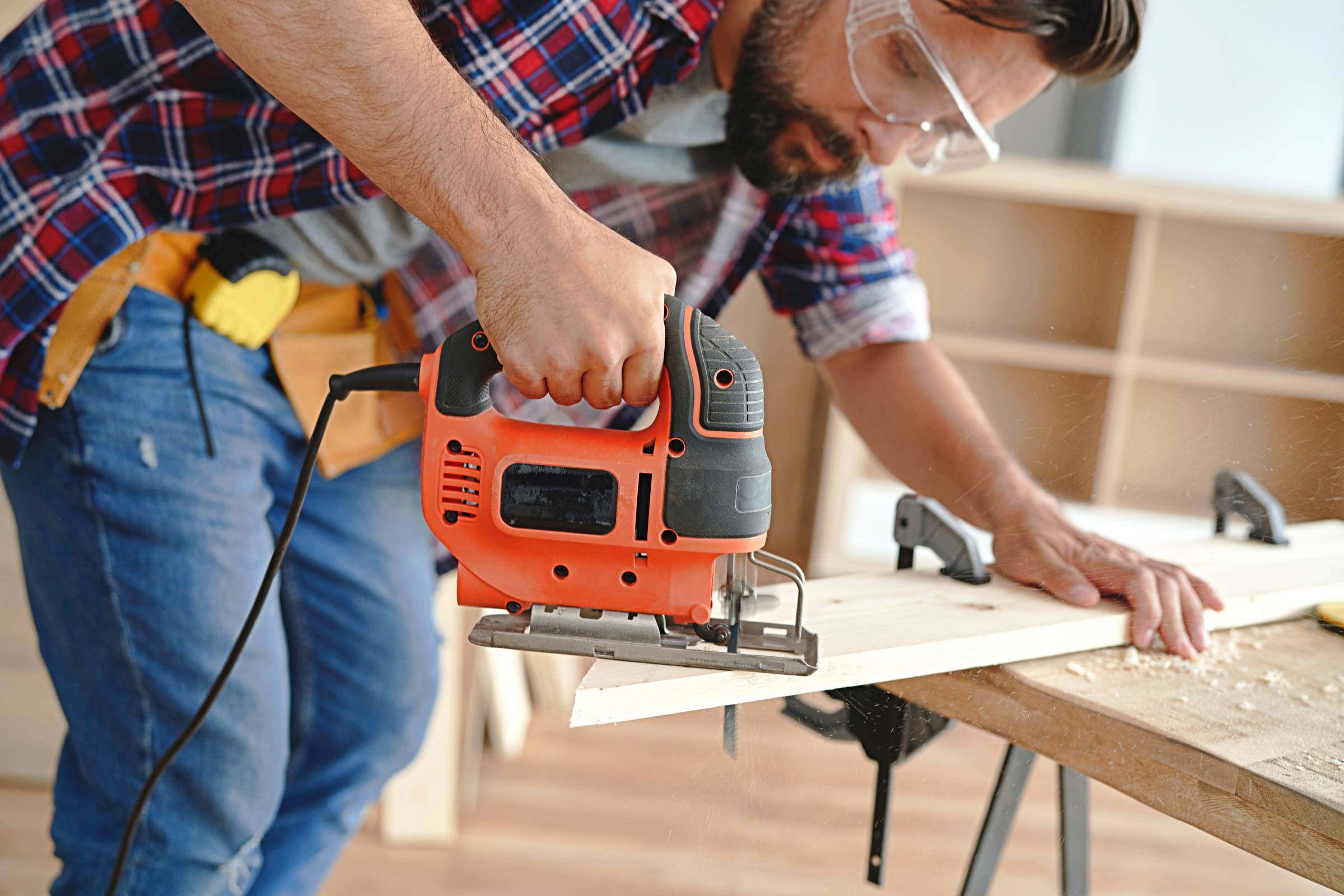 Jigsaws are perfect for making curved or intricate cuts in wood (Source: iStock)
Jigsaws are perfect for making curved or intricate cuts in wood (Source: iStock)
Unlike hand-operated carpenters tools such as claw hammers, hand saws, or screwdrivers, power tools are operated by electricity or batteries. Many tasks are now faster, easier, and more consistent.
Power tools are available in two types:
Cordless tools such as power drills and drivers run on lithium-ion batteries. They are portable and convenient because you won’t need extension cords or be near an outlet. However, they have limited run time per battery charge.
Corded tools provide unlimited runtime and are typically more durable and powerful than cordless. But cords can get in the way or pose tripping hazards.
A common tip is to use cordless power tools for portable convenience, while corded tools are better for stationary shop tools, such as a circular saw, that will have constant heavy use.
Either way, these are the power tool names professional carpenters should remember:
16. Orbital sanders
An orbital sander is one of the most common woodworking power tools. It has a round sanding pad that oscillates in small circles to sand wood surfaces smoothly.
The circular orbital action helps prevent visible scratch patterns that you can get from straight-line sanding. It also removes drips, brush marks, or surface imperfections, making it the right tool for finishing.
17. Grinders
Grinders are some basic carpentry tools for sharpening and maintaining cutting tools. In particular:
An angle grinder is a handheld rotary tool that uses grinding and cutting wheels for metal tasks. Carpenters use it to sharpen dull mortise chisels and blades, restoring a keen edge.
A bench grinder is a fixed grinding machine with a spinning abrasive wheel to sharpen or deburr metal tools. It lets carpenters set and maintain the optimal bevel angles on their blade edges.
18. Compound miter saws
A compound miter saw is an important tool for making precision crosscuts and angled cuts. Unlike a basic miter saw, which only pivots left and right for miter cuts, this one has a head that rotates side to side and tilts forward and back. This allows miter and beveled cuts, ideal for crown molding, baseboard, door casing, and window frame fittings. Additionally, a fence provides stability and length stops for repetitive cuts.
19. Power drills
A power drill bores holes in wood, metal, and other materials. Its rotary action makes quick work of holes needed for shelving uprights, furniture assemblies, or other wood pieces.
A pneumatic drill powered by compressed air achieves greater depths for very deep holes. Connected to a shop air compressor, it becomes the right tool to punch through denser hardwoods, where a standard power drill might struggle.
20. Circular saws
A circular saw has a round blade that spins to cut through lumber and sheet goods like plywood. Its compact size and lightweight design allow a carpenter to bring the saw to the workpiece. By adjusting its cut depth and using an edge guide, the circular saw produces long, straight, repeatable cuts not feasible with a handsaw.
When building custom shelves and cases, a circular saw is ideal for breaking down plywood and dimensional lumber to required sizes. Quick straight cuts help produce shelving and cabinet components that fit together cleanly. A sharp carbide-tipped blade of this woodworking tool cuts smooth edges, reducing sanding time later.
21. Nail guns
A nail gun is one of the essential tools for woodworking, allowing rapid and consistent nailing. With compressed air, it quickly drives nails into wood with just a gentle push against the material.
With adjustable depth and pressure settings, carpenters can tune this handy tool for different nailing tasks. Light pressure prevents driving nails too deep and damaging wood, while maximum pressure sinks hardened ones into dense materials. Angled nail guns fit in tight spots.
Use your carpentry skills to earn money with Airtasker
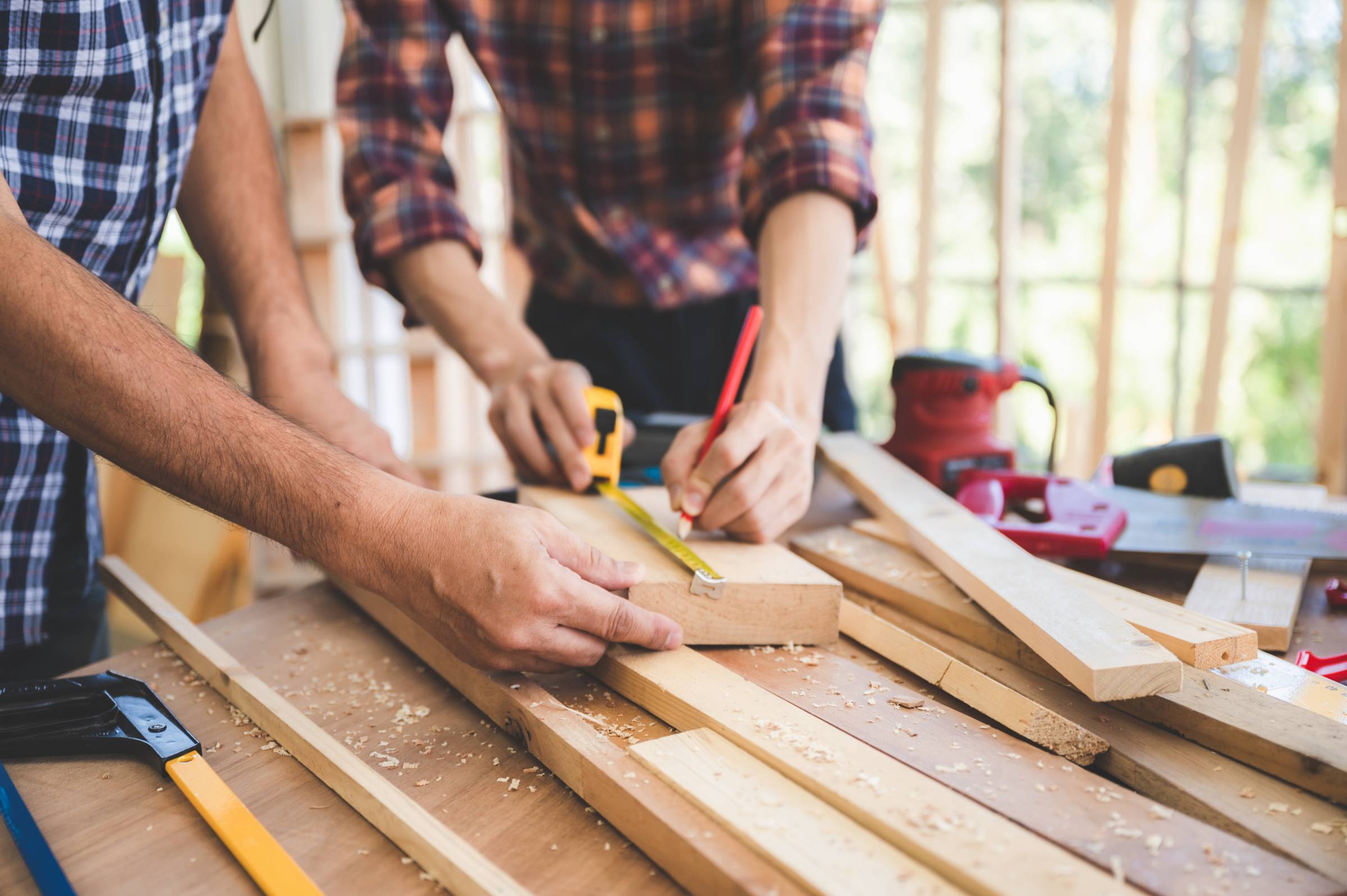 Precision is key—measure twice, cut once remains a golden rule (Source: iStock)
Precision is key—measure twice, cut once remains a golden rule (Source: iStock)
Whether you’re a professional carpenter or a handy DIYer, you can make money completing carpentry tasks with basic carpenter tools like a utility knife, claw hammer, and more.
Some carpentry and joinery jobs pay quite well. In the US, the average rate for a carpenter is up to $300, based on experience, location, and project complexity.
With Airtasker, you set your rate and choose which projects to accept. Carpentry opportunities include:
Furniture assembly
Door, window, and floor fitting
Home repairs
Custom furniture design and shelving
Fence and deck construction
Drywall patching
To get started:
Create a free Airtasker account.
Describe your carpentry background and list the basic tools you own.
Include photos of past project examples.
Set your preferred rate and service area availability.
This complete list of carpenter tools can help you take on different projects. Don’t have all of the tools above? That’s perfectly fine.
You can always begin with some essentials, especially if you want to save money. These include a utility knife, a claw hammer, and a block plane. You can also buy core power tools, such as drills. What matters more is jump-starting your career in carpentry today.
FAQs about carpentry tools
A claw hammer is one of the most common carpenter tools because it is reliable for various projects. It can be used to remove and drive nails, pry materials, and make adjustments.
With a carpentry apprentice tool kit, an apprentice carpenter can construct cabinets, build furniture, fit doors and windows, attach flooring, and make fences, decks, and other wood structures.
The measuring tool used most often in woodworking is a tape measure, which is essential among the various tools for taking dimensions and marking measurements precisely. As one of the joinery tools, it allows a woodworker to gauge accurately and lay out the cuts, joinery, and sizing to fit pieces together during projects from start to finish.
Basic woodwork tools include hammers for driving and removing nails, saws for cutting materials, drills for boring holes, levels for ensuring straight and plumb structures, tape measures and rulers for layout, clamps to hold pieces in place, squares for accurate angles, and planes or sanding blocks for smoothing surfaces. These fundamental hand tools and basic power tools equip a carpenter to complete various woodworking and home improvement projects.
Find carpenters, fast
Find a carpenter
Related articles
Related price guides


